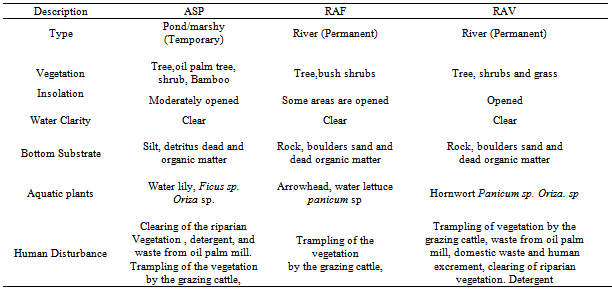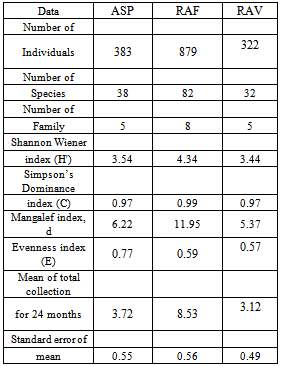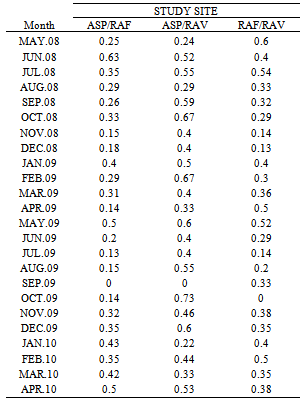-
Paper Information
- Next Paper
- Previous Paper
- Paper Submission
-
Journal Information
- About This Journal
- Editorial Board
- Current Issue
- Archive
- Author Guidelines
- Contact Us
International Journal of Agriculture and Forestry
p-ISSN: 2165-882X e-ISSN: 2165-8846
2013; 3(6): 231-239
doi:10.5923/j.ijaf.20130306.05
Diversity and Community Structure of Dragonflies and Damselflies (Insecta: Odonata) in Aponmu Forest, Southwestern, Nigeria
1Department of Biological Sciences, Ondo State University of Science and Technology, Okitipupa, Ondo State, Nigeria
2Department of Zoology Obafemi, Awolowo University, Ile-Ife 220005, Osun State, Nigeria
Correspondence to: Adu B. W, Department of Biological Sciences, Ondo State University of Science and Technology, Okitipupa, Ondo State, Nigeria.
| Email: |  |
Copyright © 2012 Scientific & Academic Publishing. All Rights Reserved.
A survey of Odonata fauna inhabiting Aponmu Forest in Ondo State, southwestern Nigeria was carried out from May 2008 to April 2010, with a view to determining its diversity and distribution and community structure. Three study sites were identified: Ago-Store Pond (ASP), River Aponmu in Forest (RAF) and River Aponmu in Village (RAV). Data collected from the study sites were subjected to diversity indices and Soerensen’s Quotient (SQ). One hundred and three species of dragonfly and damselfly were recorded at the forest. These species represented 44 genera in 8 families. Eighteen out of the 103 species were new records in Nigeria. RAF was the site with most diverse odonate fauna (Shannon Wiener index (H' = 4.34), Simpson’s Dominance index (C = 0.99), Mangalef index, d = 11.95) while the least was RAV (Shannon Wiener index (H’ = 3.44), Simpson’s Dominance index (C = 0.97), Mangalef index, d = 5.37). The distribution of the fauna was however the best at ASP (Evenness = 0.77). ASP and RAV were the paired sites with similar Odonata community structure. Most of the new records recorded for the country were collected at RAF. However most of the species collected were eurytopic type. This result proof that most species with narrow niches could not tolerate the anthropogenic activities in the forest. It therefore important to pay attention to conservation of the forest natural resources so as to prevent further the depreciation of the forest biodiversity.
Keywords: Dragonfly, Distribution, Aponmu, Community Structure, Forest, Disturbance
Cite this paper: Adu B. W, Ogbogu S. S, Diversity and Community Structure of Dragonflies and Damselflies (Insecta: Odonata) in Aponmu Forest, Southwestern, Nigeria, International Journal of Agriculture and Forestry, Vol. 3 No. 6, 2013, pp. 231-239. doi: 10.5923/j.ijaf.20130306.05.
Article Outline
1. Introduction
- Odonata (dragonflies and damselflies) is a well studied insect Order. It is highly diverse, with two Suborders: Anisoptera (Dragonfly) and Zygoptera (Damsefly). This insect order is well represented in Afrotropical forests and can be found in all kinds of freshwater habitats within the ecosystem. Some species are known to inhabit brackish water[1]. Two members of the Family Aeshnidae, Oligoaeshina pryeri and Sarasaechna pryeri have been observed in moist soil littered with decayed vegetative matter[2],[3] and[4]. Some species are found roaming widely (especially the ubiquitous such as Palpopleura Portia, Orthetrum Julia,and Sympetrum navasi) and sometimes found wandering far away from their habitat. The adult and larval of this insect order are sensitive to environmental changes an attribute that suggests the basis why they are being used as bioindicator.[5]. Not many works have been carried out on Odonata fauna of Nigeria forest moreover there have been continuous environmental changes such as forest fragmentation. The tendency of Odonata to respond to these changes in environmental conditions with particular reference to tropical forest biodiversity necessitated up-to-date information on the fauna and also the use of the information to determine the effect of anthropogenic activities on forest ecosystem.This research will add to the body of knowledge of Odonata fauna of tropical forest, with particular reference to Aponmu Forest in Nigeria in a number of ways. It is expected to determine the richness of the taxon in the forest, reveal the community structure and distribution of dragonflies and damselflies of the forest provide a checklist of dragonflies and damselflies of Aponmu Forest and add to the existing list of Nigeria’s Odonata fauna. To achieve these, two objectives were considered. The objectives are to determine the abundance and distribution of dragonfly and damselfly in Aponmu Forest and to compare the Odonata community structure of the three study sites located in the forest
1.1. Aponmu Forest
- Aponmu Forest (07°12.54ʹ N - 07° 13.83ʹN and 005° 02.29ʹE - 005° 03.63ʹ E) is in southwestern, Nigeria. It is in Guineo-Congolian subkingdom: a member of Paleotropical Kingdom. Guineo-Congolian lowland rainforest is a continuous forest that runs from Uganda to Sierra Leone[6]. This region is known to be rich in Odonata fauna therefore Aponmu forest cannot be an exception since it is within the ecozone. Guineo-Congolian lowland rainforest is known to be rich in Odonata fauna.Aponmu Forest is named after River Aponmu, a river that flows through the forest as well as Aponmu village. The forest houses a pond (Ago-Store Pond) at a camp located at the western part of the forest. The surroundings of the pond can be very marshy especially during the wet season. Part of the pond is shaded, this as a result the riparian vegetation such as short trees and bamboo which cast shade on part of the pond, other riparian vegetation at the pond include shrub and grass. Aponmu forest is characterized by two major seasons; dry and wet seasons. Heavy rains characterize the wet season, while the dry season exhibits dryness. The sun shines throughout the year and the average monthly ambient temperature is between 28.40°C and 31.26°C. The water level of River Aponmu reduced drastically, while the pond dropped to bottom level during the dry season. The wet season is characterized by increased water current velocity, while the pond overflows its bank thereby making the surroundings marshy.
2. Materials and Methods
2.1. Study Sites
- Three study sites were identified in the forest. Selection of the sites was based on the physiognomy of the two prominent water bodies within the forest (River Aponmu and Ago-Store Pond). Two study sites were located on River Aponmu: River Aponmu in the Forest (RAF) and River Aponmu in the Village (RAV). The third study site is Ago-Store Pond (ASP) in Ago-Store camp. Tables 1 and 2 give geo-reference coordinates of the study sites and their brief descriptions respectively. All the study sites were experiencing anthropogenic activity but very minimal at RAF. However the menace of cattle trampling and grazing on the vegetation is a common sight at the three study sites (Table 2).
2.2. Sampling Methods
- Only adult specimens were sampled in this study this is due to ease of accurate identification of the adult specimens. Sampling of the adults was carried out using insect sweep net once a month for a period of two years (May, 2008 to April, 2010), between 10.00 a.m. and 4.00 p.m. under favourable weather conditions. All encountered species of dragonflies and damselflies within 500 m along the shore line of each study site were combed for dragonflies and damselflies specimens. Specimens that were caught were carefully kept in small triangular envelopes with the wings placed together at the back so as to prevent the wings from being rumpled and then labelled[7]. Male and female caught in tandem were placed together inside an envelope. Data of species collected were taken monthly based on the study site where the specimen was collected, date of collection, and prevailing environment condition of the site at the time of sampling.
|
|
2.3. Preservation of Adults
- All the specimens collected were killed by dipping them in acetone for a minute after which each specimen was removed and body arranged in proper pattern. Large-sized specimens were killed by injecting acetone into the thorax and base of the abdomen[7]. All the specimens were then kept in acetone for a minimum of 12 hours so as to ensure absorption of sufficient acetone to enhance embalmment. They were air-dried on tissue paper thereafter. Each of the specimens was then kept in a transparent small nylon bag, sealed and then placed inside a 3 x 5 cm envelope. All envelopes were labeled with specimen locality (including the study site), type of water body (e.g. River), name of water body (e.g. RAV), and date of collection. The specimens were then stored in insect boxes.
2.4. Odonata Community Structure in Aponmu Forest
- Odonata community structure (OCS) of the study sites was compared. This was carried out in order to determine the similarity and dissimilarity in the community structure of the species of Odonata found occurring at the three study sites. For this purpose Soerensen’s Quotient (SQ)[8] was used. SQ has the advantage of not requiring an estimate of the number of individuals of each species[8]. Soerensons Quotient (the SQ value) for sites X and Y is given as 2J/ (A+B) where:A = number of species in site XB = number of species in site YJ = number of species common to bothThe value will be close to 1.0 for sites that have most of their species in common and for very dissimilar sites the value would be close to 0.0. Coefficient of similarity was estimated for the value obtained in SQ analysis[9],[10]. <0.3 = strongly dissimilar, 0.3-0.4 = moderately dissimilar, 0.4-0.5 = slightly dissimilar, 0.5-0.6 = slightly similar, 0.6-0.7 = moderately similar, > 0.7 = strongly similar.The percentages of similarity were on the basis of number of months of similarity in the OCS: 0-39% = not similar, 40-64% = similar, 65 -100% = most similar.
2.5. Identification of Specimens
- All specimens collected were identified to the lowest taxonomic level using standard identification manuals which include[11],[12],[13]. They were also cross-referenced against over 2892 images of Afrotropical species of Odonata on the World Wide Web(www.africa-dragonfly.net/global/results).
2.6. Data Analysis
- Biodiversity indices were used for the determination of species diversity at sites. The biodiversity indices used include Shannon-Wiener diversity index (H') and Evenness (E)[14],[1] Simpson’s Dominance index[15], and Mangalef index[15]. The higher the value of H', the greater the diversity and the cleaner the environment[16], and[17]. Odonata community structures (OCS) of the study sites were compared. Coefficient of similarity was estimated from the value obtained in SQ analysis following Bray and Curtis[9] and Sarmistha et al.[10] and the percentages of similarity were determined.
3. Results
3.1. Composition of Odonata Fauna in Aponmu Forest
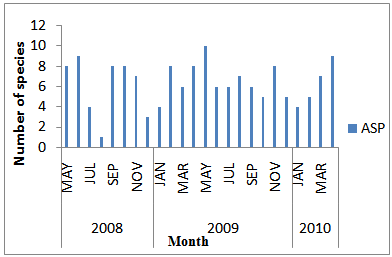 | Figure 1. Monthly collection of species of Odonata at Ago-Store Pond (ASP), May 2008-April 2010 |
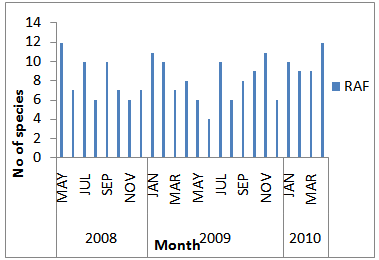 | Figure 2. Monthly collection of species of Odonata at River Aponmu in Forest (RAF) May 2008-April 2010 |
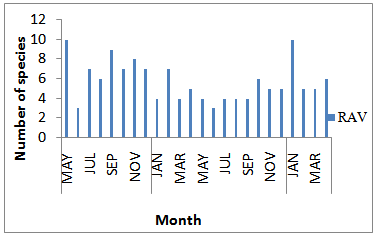 | Figure 3. Monthly collection of species of Odonata at River Aponmu in the Village May 2008-April 2010 |
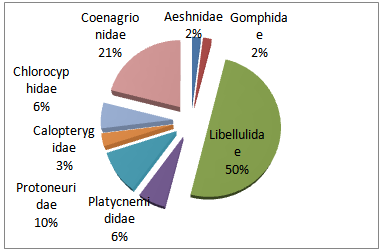 | Figure 4. Percentage composition of families of Odonata in Aponmu Forest, May 2008 -2010 |
3.2. Odonata Diversity and Distribution in Aponmu Forest
- The richest study site was RAF (Shannon Wiener index (H') =4.34, Simpson’s Dominance index (C) = 0.99 and Mangalef index, d = 11.95). This study site also had the highest number of species (82 species in 8 families) and the evenness value of E = 0.94. Based on this value, the species were well distributed but not the best in the forest. RAV had the highest evenness value (0.97), which shows that the distribution of species of Odonata was the best at the site. The study site (RAV) however had the least number of species (32) and also the least in term of species diversity (Shannon Wiener index (H') =3.44, Simpson’s Dominance index (C) = 0.97 and Mangalef index, d = 5.37) least number of species (32) and was the poorest in terms of species diversity (H' = 3.44). Thirty eight species were represented at ASP and next to RAF in terms of species richness (Shannon Wiener index (H') = 3.56, Simpson’s Dominance index (C) = 0.97 and Mangalef index, d = 6.22), (See table 3).
|
3.3. Odonata Community Structure in Aponmu Forest
- ASP and RAFASP and RAF have three months of similar Odonata fauna occurring out of 24 month duration of the study. The months with similar community structure were June 2008 (SQ=0.63: moderately similar, May 2009 = 0.5 and April 2010 = 0. 5).The SQ value obtained for the twenty-one months range from 0.0 to 0.43. The percentage of similarity was 12.5%. This finding shows that OCS between ASP and RAF was not similar. (Table 4)ASP and RAVASP and RAV have similar Odonata community structure in 11 out 24 months duration. The SQ values for the eleven months ranged from SQ 0.5 to 0.73. Based on this finding, the percentage of similarity was 45.8%. The thirteen months of dissimilarity have SQ value ranging from 0.0 to 0.44. This finding shows that the two study sites have similar OCS (Table 4).RAF and RAVThe two study sites are on the same river, but in different locations and are going through different environmental impacts. RAF is in the forest while RAV is within Aponmu village. There are only five months of similarity. The months were May 2008 (SQ: 0.6), July 2008 (SQ: 0.54), April 2009 (SQ: 0.5), May 2009 (SQ; 0.52), and February 2010 (SQ: 0.5). The other months have SQ values ranging from 0.0 to 0.4 (Table 4). The percentage of similarity is 20.8% which shows that the OCS at the sites was not similar.
|
4. Discussion
4.1. Odonata Diversity and Habitat Selection
- Aponmu Forest is gradually losing the characteristics of a climax tropical rain forest. It however had the right vegetation architecture in some part of the forest which is required by Odonata larvae and adults. The water bodies located in the forest also provide the needed biotope for the survival of many Afrotropical species. The tree crowns provide the right roosting spots for the adult while the undergrowth and shrub provide perching spots fort the low flying adults. Also there are fragmented openings within the forest which serve as mating rendezvous for mature adults, especially at open water bodies. Odonata displays two behavioural characteristics which is a function of the habitat selection of the species (eurytopic and stenotopic). In between these two are the temperate-centered species, species that are neither eurytopic nor stenotopic[18] Habitat occupied by Odonata may sometimes be unconventional for its type. For example a (Phaon iridipennis is, a forest odonata was found in Aponmu village (RAV). This is an environment that is experiencing regular human disturbances. Also some species of Mesocnemis singularis, Oreocnemis phoenix, and Acisoma panorpoides that are usually associated with rivers[19] or streams were encountered at the vicinity of ASP.[20] also observed that Pantala flavescens associated with streams and rivers were found in a lake in Botswana. This shows that Odonata exhibits heterogeneity in habitat selection, especially when the best desired habitat is not available[18]. The most abundant species at Aponmu forest was Orthetrum chrysostigma. O. chrysostigma is a good colonizer and the type that are usually found in environment that are experiencing anthropogenic activity. With the O.chrysostigma dominating other species in the forest in terms occurrence and distribution, it can be speculated that the forest is disturbed.
4.2. Pattern of Occurrence of New Records of Odonata at the Three Study Sites
- This study added eighteen new records of Odonata to the existing records of Nigeria insects. Most of the species are from RAF, followed by ASP, the least was from RAV. RAF: They include three members of family Protoneuridae (Elattoneura pasquinii, Teinobasis alluaudi and Elatoneura lliba), three species of Coenagrionidae (Pseudagrion torridum, Aciagrion heterostica and Teinobasis alluaudi) and four species of Libellulidae (Atoconeura luxata, A. eudocia, Tetrathemis fraseri, and Zygonoides fuelleborni) (See Appendix). All the species preferred open places in the forest[21],[11]. The two species of Atoconeura prefer montane forest with cool environment. Tetrathemis fraseri and Zygoinoides fuelleborni are lovers of Forest River with a lot of openings[12]. Other new records of Odonata collected from River Aponmu include two members of family Chlorocyphidae (Chlorocypha radix and C.pyriforma (See Appendix). All the species were found to have been collected elsewhere in tropical Africa: in Ghana, and Liberia[22],[23]. The two species were collected at a shaded bank of the river. The two species were found coexisting in the same habitat this type of occurrence was also recorded by in Atewa, Ghana and in Liberia[22],[23].ASP: Five new records of Odonata species were discovered at ASP. Two of the species are forest Libellulidae (Atoconeura eudocia and Trithemis hatwigi). A. eudocia species was not expected at this site because they are known to prefer sluggish shaded montane forest streams, characterized by fragmented openings which was absent in ASP. This was the only sample of A.eudocia collected at the pond. One possible reason for this is that it strayed into the vicinity of the pond. However, T. hatwigi sampled at the site is known to prefer pools of water as a habitat[11]. Therefore the pond vicinity is a good habitat for the species. Four other new records of Odonata species identified at the sites are members of the Coenagrionidae. The species are Aciagrion heterostica, Africallagma vaginale, Ceriagrion whellani and Pseudagrion bernadi . All the four species prefer standing water and swampy patches[11]. Some specimens of A. heterostica were collected at the forest adjacent to the ASP. The occurrence of A. heterostica at a forest experiencing anthropogenic activities revealed that the species can tolerate some levels of disturbance at the site[24]. Africallagma vaginale was more prominent at the forest adjacent to the pond than at the pond or its marshy surroundings. Specimens of Ceriagrion whellani were collected at the small runnel of the pond that flows into the forest. RAV : Two new records of dragonfly and damselflies were observed in RAV. The species are Micromacromia miraculosa (Libellulidae) and Elattoneura lliba (Prontoneuridae). Micromaromia miraculosa was collected near a small stream that flows into the river at the south west of Aponmu village. The stream was quite calm in terms of human disturbance contrary to what was observed at the river in Aponmu village. One of the disturbances at the site includes occasional vegetative clearance. Elattoneura lliba was collected at the same stream where Micromacromia miraculosa was collected. E.lliba was expected to occur in large stream or the small river. Its presence at this small stream may be as a result of the closeness of the stream to the river and also the presence of shade trees at the stream.
4.3. Habitat Degradation and Effect on Odonata Fauna
- As human populations grow daily with associated general alteration of the natural landscape (especially through deforestation, urbanization and agricultural encroachment) and the subsequent alteration of water bodies (by erosion, eutrophication and siltation)[25]. This is the main threat to Odonata in West Africa and indeed the tropics worldwide. The need for man to survive harsh economic problems constituted a major challenge to ecological preservation of natural resources in Nigeria[26]. In the seventies and early eighties, River Aponmu and environs were known for their serenity[27]). Today the river bank has become a beehive of activities (especially the site in the village; RAV). Palm oil mills are located along the bank and industrial wastes from the mills are channeled into the river with impunity at the site in the village (RAV). Heaps of palm kernels shell, decaying organic matter and other domestic wastes pile up along the river banks, resulting in degradation of the riparian vegetation of the river. RAV was the most disturbed site, a situation that must have led to habitat shift of the stenotopic species residing in the site. Some stenotopic species were collected at RAF. The presence of stenotopic species at RAF suggests that the Odonata status of the RAV was the same as RAF before the degradation.
5. Conclusions
- For now, most forest stenotopic species of Odonata appear to survive in the remaining fragments of natural forest while the ubiquitous species are found roaming about in open areas within the forest. The absence of some of forest Odonata species at ASP and RAV is a call for urgent action which should be taken to preserve the natural resources in the forest. Also, the survival of the remaining forest species is doubtful in a few years to come if no action is taken to preserve the forest biodiversity. Therefore the activities of the illegal timber contractors, palm oil millers and the villagers should be checked so that these few forest species and other threatened organisms in the forest could be preserved. With the situation on ground one can conclude that Aponmu Forest is not protected and the natural resources within the forest are being over-exploited. This situation is detrimental to the assemblage of localized Odonata species and perhaps other organism inhabiting the forest. There is need to preserve the Odonata community of the Aponmu Forest, which off course cumulated to the preservation other fauna occupying the forest. Maintaining the structural integrity of the surrounding landscapes in the forest will enhance the conservation of dragonfly and damselfly species of the forest and other organisms as well.
ACKNOWLEDGEMENTS
- Special thanks to Federal Ministry of Environment and Ondo State Ministry of Natural Resources for granting us access to Aponmu Forest.
Appendix
- A Checklist of Species of Odonata fauna of Aponmu Forest May 2008 to April 2010. Abbreviation: ASP= Ago-store pond, RAF= River Aponmu in Forest, RAV= River Aponmu in Village and *= New Record in Nigeria
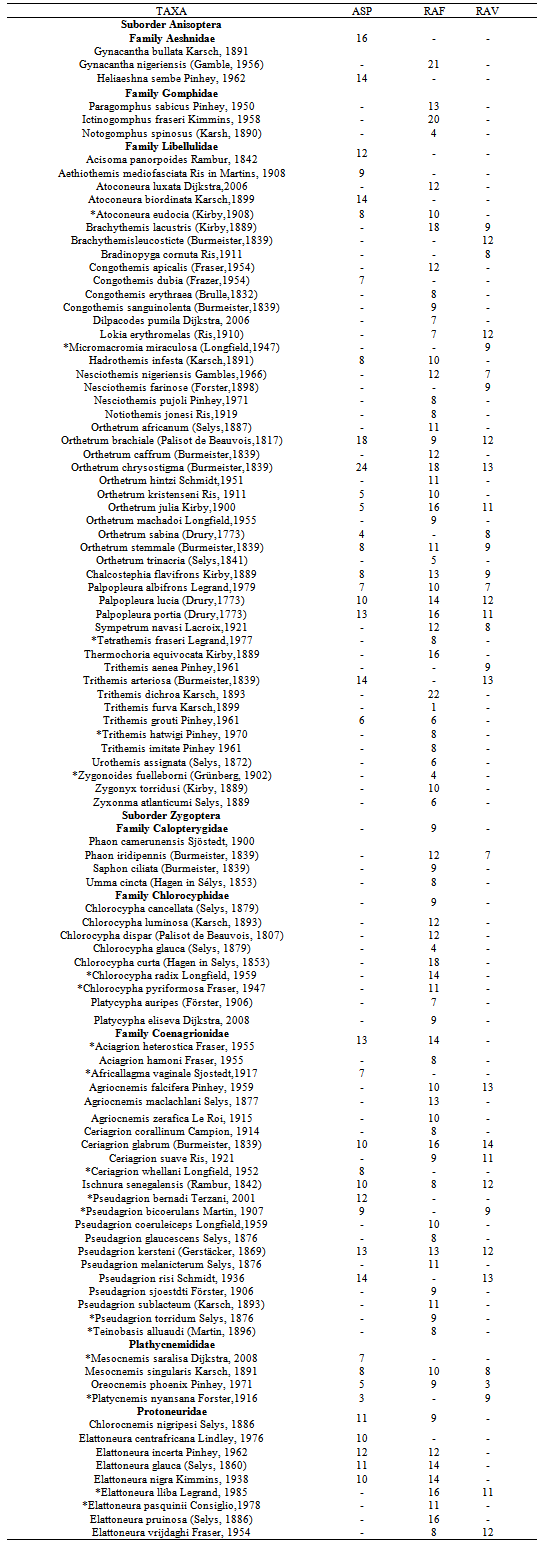
 Abstract
Abstract Reference
Reference Full-Text PDF
Full-Text PDF Full-text HTML
Full-text HTML
